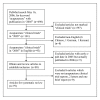How might acupuncture work? A systematic review of physiologic rationales from clinical trials
- PMID: 16824230
- PMCID: PMC1523365
- DOI: 10.1186/1472-6882-6-25
How might acupuncture work? A systematic review of physiologic rationales from clinical trials
Abstract
Background: Scientific interest in acupuncture has led numerous investigators to conduct clinical trials to test the efficacy of acupuncture for various conditions, but the mechanisms underlying acupuncture are poorly understood.
Methods: The author conducted a PubMed search to obtain a fair sample of acupuncture clinical trials published in English in 2005. Each article was reviewed for a physiologic rationale, as well as study objectives and outcomes, experimental and control interventions, country of origin, funding sources and journal type.
Results: Seventy-nine acupuncture clinical trials were identified. Twenty-six studies (33%) offered no physiologic rationale. Fifty-three studies (67%) posited a physiologic basis for acupuncture: 33 (62% of 53) proposed neurochemical mechanisms, 2 (4%) segmental nervous system effects, 6 (11%) autonomic nervous system regulation, 3 (6%) local effects, 5 (9%) effects on brain function and 5 (9%) other effects. No rationale was proposed for stroke; otherwise having a rationale was not associated with objective, positive or negative findings, means of intervention, country of origin, funding source or journal type. The dominant explanation for how acupuncture might work involves neurochemical responses and is not reported to be dependent on treatment objective, specific points, means or method of stimulation.
Conclusion: Many acupuncture trials fail to offer a meaningful rationale, but proposing a rationale can help investigators to develop and test a causal hypothesis, choose an appropriate control and rule out placebo effects. Acupuncture may stimulate self-regulatory processes independent of the treatment objective, points, means or methods used; this would account for acupuncture's reported benefits in so many disparate pathologic conditions.
Figures
References
-
- Hennekens CH, Buring JE, Mayrent SL. Epidemiology in medicine. 1. Boston: Little, Brown; 1987.
-
- Acupuncture: How might acupuncture work? 2006. http://nccam.nih.gov/health/acupuncture/#how 2-8-2006. Ref Type: Electronic Citation. - PubMed
-
- Stux G, Hammerschlag R. Clinical Acupuncture: Scientific Basis. Berlin: Springer-Verlag; 2001.
-
- Altman DG, Schulz KF, Moher D, Egger M, Davidoff F, Elbourne D, Lang T, CONSORT GROUP The revised CONSORT statement for reporting randomized trials: explanation and elaboration. Ann Intern Med. 2001;134:663–694. - PubMed
Publication types
MeSH terms
Substances
LinkOut - more resources
Full Text Sources
Medical


